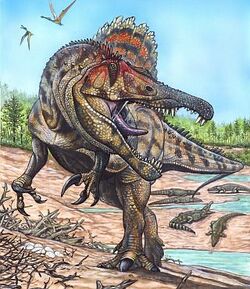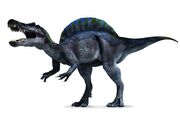| Oxalaia | |
|---|---|
 | |
|
Scientific classification |
|
|
Kingdom |
Animalia |
|
Phylum |
Chordata |
|
Class |
Sauropsida |
|
Superorder |
|
|
Order |
|
|
Superfamily |
Spinosauroidea |
|
Family |
|
|
Genus |
Oxalaia |
Oxalaia was a genus of very large theropod dinosaurs native to Brazil and dating from the Middle Cretaceous period, approximately 98 MYA. Oxalaia may have been the second-largest theropod of all time after Spinosaurus, its close relative native to northern Africa. Although its fossils are extremely fragmentary, estimates of its size range from 12-14 meters in length. Based on Spinosaurus, Oxalaia probably weighed around 7-10 tons.
Discovery and fossil record[]
Oxalaia is known from the holotype MN 6117-V, fused premaxillae of a very large individual and from the referred fragment MN 6119-V, an isolated and incomplete left maxilla, which were found on Cajual Island, Maranhão State of northeastern Brazil. Fossils of Oxalaia were recovered in 2004 from the Laje do Coringa locality of the Alcântara Formation, part of the Itapecuru Group of the São Luís Basin. Besides these bone fragments, numerous spinosaurid teeth had earlier been reported from the site.
The genus was named by Alexander Wilhelm Armin Kellner, Sergio A.K. Azevedeo, Elaine B. Machado, Luciana B. Carvalho and Deise D.R. Henriques in 2011 and the type species is Oxalaia quilombensis. The specific name quilombensis refers to the quilombo settlements, such as on Cajual Island, which were founded by escaped slaves.
Description[]

Another depiction.
Oxalaia was a giant predator, likely similar in appearence to a cross between its two closest relatives: the larger, African Spinosaurus and the smaller, South American Irritator. It would have had the slender body typical of spinosaururids, with long, powerful front legs with hooked claws. The jaws were presumaly long and narrow, filled with sharp teeth. It may have also had a fatty hump on its back, similar to Spinosaurus.
Based on size estimates, Oxalaia would have either been the second or third-largest theropod ever to live. The lowest estimates state it at 12 metres (39.7 feet) long and 6 tons; the highest estimates state it at 14 metres (46 feet) long and approximately 9 tons.
Oxalaia may or may not have been an adult specimen of the closely related Irritator, a smaller spinosaurid also native to South America. If this is true, the name Oxalaia will be invalid and the animal will be referred to as Irritator.